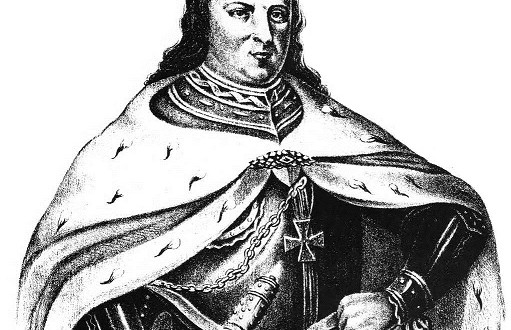by Tomas A. Michalskis,Ph.D.
Vytautas the Great
VYTAUTAS THE GREAT (1350- J1430), the eldest son of Birute rand Kestutis was born into a troubled world. It was a time in which the very existence of the Lithuanian people and emerging state were seriously threatened. Internally, Lithuania was both blessed and cursed by the appearance of almost too many capable, brilliant yet factious and ambitious leaders. Often they were at odds with one another to the detriment of the Lithuanian people. The country was plagued by turmoil. Mindaugas had been assassinated at an earlier date. Kestutis was strangled while under the roof of his nephew Jogaila. To the west, Lithuania was threatened by the Teutonic Order, a German religious military organization. The Teutonic Knights traced their origin to the crusades. After the end of the crusades against the Saracens in the Holy Land, they sought another mission and found it on the shores of the Baltic Sea.
With the blessing of both the Pope of Rome and the Emperor of the Holy Roman Empire, the Teutonic Knights entrenched themselves on the Baltic littoral, at a time when the Baltic peoples, among them the Lithuanians, were yet disunited. The Teutonic Knights vanquished one Baltic people after another. They conquered the Pomeranians, and the Prusai or Old Prussians from whom Prussia took its name. They subjugated the Letts and the Livs in what is now Latvia and Estonia. They threatened and cajoled the Masurians, a Slavic people in what is now north central Poland. They attacked the Finns and the Russians in their attempts to subjugate the area around Novgorod and Pskov in northwestern Russia.
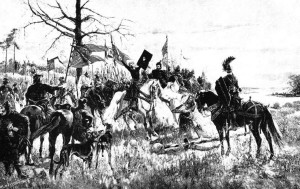
During the reign of Gediminas (1316- 1341) the Teutonic Knights began their systematic onslaughts against Lithuania with the backing of the German states, England, France, the Scandinavian countries and Bohemia. Lithuania stood virtually alone against the combined military and technological might of almost all of western Europe. To make a bad situation even worse, the German “Drang nach Osten” or “Drive to the East” was blessed by the Pope and sanctioned by the Emperor in the name of Christ. The Baltic shores were to be baptized in blood and thoroughly Germanized in the process. The conquered Prusai did not accept German rule passively. They rose twice against their oppressors during the period 1242-1249 and again between 1260-1274. They were brutally suppressed each time.
The war betw een the Teutonic Knights and Lithuania lasted some two hundred years. Lithuania withstood massive attacks by the Teutonic Knights who were not simply content with “baptizing” the non-Christian Lithuanians. They often terrorized and wasted the neighboring Catholic Poles and Eastern Orthodox Christians in the north of Russia when it was convenient, without much resistance.
Lithuania, especially Žemaitija, suffered terribly. The land was repeatedly ravaged by fire and sword. Agriculture and the economy were in constant shambles. Trade was destroyed. The population was consistently decimated. The natural growth of the nation was stunned almost completely. Natural and normal relationships between Lithuania and the rest of Europe were interrupted for some two hundred years. Cultural development was retarded. Above all, the Christianizing of the nation was set back generations when all of the rest of Europe had accepted Christianity either from Rome or Byzantium. Christianity, and especially Roman Catholicism, became repugnant to Lithuanians in general but particularly to the Žemaiciai who bore the brunt of what was blasphemously called “Christianizing” by the Germans who “baptized” in blood,by fire and sword.
To survive, Lithuania needed allies. Both King Jogaila and his cousin Vytautas looked southward. Poland was both a victim of the Teutonic Knights and a Roman Catholic country. To mute the anti-Lithuanian propaganda spread by the Teutonic Knights throughout western Europe, Jogaila agreed to accept Roman Catholicism through Poland. He became king of Poland in 1386, with the understanding that Lithuania would be baptized into the Roman Catholic faith in 1387 to be followed shortly thereafter by Žemaitija. Both Vytautas and Jogaila viewed the Polish alliance as a military and political necessity if Lithuania was to survive. Within a short time however, Vytautas and Jogaila began to differ on the nature of their understanding of the Polish alliance.

Top: Mother, Grand Duchess Birutė. Center: Wife, Grand Duchess Ona. Above: Daughter Sofija, wife of Grand Duke Vasily of Moscow
Vytautas perceived the LithuanianPolish connection as a temporary pact between two equal and sovereign nations. Jogaila, as king of Poland, saw the military alliance as the basis for a more permanent and lasting arrangement between the two countries. After all, Poland was but a fairly small country in the European scheme of things at the time, much like Bohemia. But unlike Bohemia, Poland was militarily strong. It was also economically prosperous and technologically advanced in comparison with Lithuania which had spent itself on two hundred years of wars with the Teutonic Knights, the Russians and Tartars. Lithuania had already absorbed areas much larger than Poland. She ruled Kiev, “the mother of Russian cities,” Volhynia, Podolia, and most of Ukraine, all of Belarusia and significant portions of Great Russia.
In Jogaila’s mind, Poland, too, had been joined to and added to the dynastic holdings of his family, the Gediminaiciai, known later in Poland as the Jagellonians. Jogaila opted for the essentially European-oriented Lithuania and Roman Catholicism to disarm Lithuania’s western opponents. Poland was seen as nothing more than a viaduct. Poland was to provide Lithuania with the means of entering into the mainstream of European Catholic civilization. Nationality and ethnicity were probably never uppermost in his mind or the mind of Vytautas. Both were products of their time. The concepts of nationality, ethnicity and nation states developed centuries later.
In 1410, the Lithuanian-Polish alliance bore fruit. The Teutonic Knights, their number augmented by armed forces from all of western Europe, were decisively defeated by the combined Lithuanian-Polish armed forced at Tannenberg-Grimwald in Prussia. As king of Poland, Jogaila technically outranked Vytautas, Grand Duke of Lithuania, but it was Vytautas who personally led the combined Lithuanian-Polish task force, augmented by Tartar, Belarusian, Ukrainian and Bohemian contingents, into battle. The Teutonic Knights were completely routed by Vytautas, who had been a warrior since his youth. The Teutonic Knights never seriously threatened Lithuania or Poland again. During the Protestant Reformation they were one of the first German states to accept Lutheranism and secularization. The battle had been won.
With the defeat of the threat from the west, Vytautas was free to pursue his plans in the Orthodox Christian east. Under Gediminas, Lithuania began to expand eastward, annexing Minsk, Vitebsk, Polotsk and parts of the region of Smolensk. Gediminas titled himself as “Rex Letwinorum et Ruthenorum” or “King of Lithuanians and Ruthenians” (Russians). Algirdas (1345-1377) continued this policy. In 1349, he conquered all of Ukraine. He attacked Moscow itself, three times. He allowed his sons, whom he appointed as his representatives in the east, to accept the Eastern Orthodox faith of their subjects.
Vytautas followed the policy of his predecessors. Under his reign, Lithuania extended from the Baltic to the Black Sea. He reoccupied Smolensk, waged several campaigns against Pskov and laid siege to Moscow several times. By diplomacy, the city state of Great Novgorod was brought into the Lithuanian political orbit. He engaged the remnants of the Tartar Golden Horde several times with unequal success. As a result he was active in their councils and exerted a great deal of influence over their policies.
Lithuanian rule was generally welcomed by the Eastern Orthodox Christian populace. Vytautas and his predecessors were just and tolerant rulers. They were the protectors and patrons of the Eastern Orthodox Church in their domains. Vytautas himself often acted as an arbiter between squabbling factions in the Orthodox Church. He actively sought the independence of the Orthodox Church in his realm in correspondence with the head of the Eastern Orthodox Church, the Ecumenical Patriarch in Turkish occupied Constantinople, as a prelude to the reunification of all Christians, both eastern and western, under his rule. He continued the policy of Algirdas. Lithuanians sent to govern Lithuania’s eastern provinces accepted the Orthodox Christian faith of their subjects. Many married Orthodox women, whose children were born into Eastern Christian Slavic culture. Their children soon adopted the language of their mothers. Within a very short time, many of the relatives of Algirdas, Vytautas and Jogaila, the descendants of Gediminas, remained Lithuanian ethically, but lost their native language as they adopted the Eastern Orthodox religion and the Slavic idiom and customs of those they ruled. Politically Lithuania absorbed much of what later was to become the western part of the Soviet Union.
Culturally and religiously, Lithuania proper was not faced with the possibility of being absorbed into the Eastern Orthodox Slavic world. After the coronation of Jogaila as king of Poland and particularly after the defeat of the Teutonic Order, Vytautas became the supreme ruler in all of Lithuania. Had he accepted Eastern Orthodoxy, no doubt he could have easily been acclaimed the first Czar of all of Russia, Belarusia and Ukraine. To have done so, he would have had to turn his back on his own Lithuanian people. He chose to remain Lithuanian for the good of his people. Having secured his power in both the east and west, Vytautas turned his attention anew to the Culturally and religiously, Lithuania proper was not faced with the possibility of being absorbed into the Eastern Orthodox Slavic world. After the coronation of Jogaila as king of Poland and particularly after the defeat of the Teutonic Order, Vytautas became the supreme ruler in all of Lithuania. Had he accepted Eastern Orthodoxy, no doubt he could have easily been acclaimed the first Czar of all of Russia, Belarusia and Ukraine. To have done so, he would have had to turn his back on his own Lithuanian people. He chose to remain Lithuanian for the good of his people. Having secured his power in both the east and west, Vytautas turned his attention anew to the Lithuanian-Polish alliance.
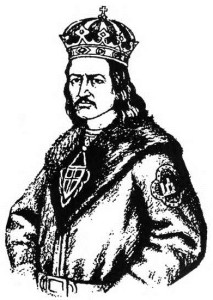
Gediminaičiai family crest on his arm.
With the passage of time, Jogaila fell more and more under the influence of the Polish nobility in Cracow. He became their prisoner in a very real sense. To them, he was always a foreigner, a non-native barbarian and doubtful neophyte Christian. He was used, misused and abused by the royal court in Cracow.
According to some historians, Jogaila often threatened to abdicate the Polish throne and return to Vilnius. He loved Lithuania, his homeland, and despised the intrigues of the Polish nobility. Yet, he knew that if he abdicated the Polish throne, it would surely fall to the German Hapsburgs. Poland itself would become vassal of German interests directed against Lithuania. He him self w ould be accused of apostasy by the Teutonic Knights. The results of the Battle of Tannenberg-G riinw ald would be undone. Lithuania would again be threatened anew by the (Germans from the west, north and south. The fledgling Roman Catholic faith in Lithuania proper would be undermined. The Eastern Orthodox Russian-oriented element in Lithuania would assume control and Lithuania would be drawn totally into the Eastern Orthodox orbit. There was no going home. He had antagonized both the non-Christian Lithuanian nobles or “bajorai” and the Eastern Orthodox nobles, among them his own relatives on his mother’s side (his mother was an Eastern Orthodox Christian) by accepting Roman Catholicism. In Lithuania, he had good reason to fear for his life. After all, Mindaugas was assassinated by Lithuanian nonChristians partially because of his acceptance of then hated Christianity. Jogaila, often maligned and denigrated by Lithuanian inter-war historians, was indeed a prisoner of history. He died the lonely death of a politically displaced person far from his beloved Lithuanian forests. He was buried in the crypt of the Royal Wawel Castle in Cracow, Poland, were he remains to this day.
Although enemies at the outset, Vytautas and Jogaila worked out their very real differences for the good of Lithuania. Jogaila furthered the political interests of Lithuania in the west with the support of Vytautas. Vytautas furthered the political interests of Lithuania in the east with the support of Jogaila, As a result, Lithuania survived 200 years of armed attack from the west, and Russian cultural and religious penetration from the east.
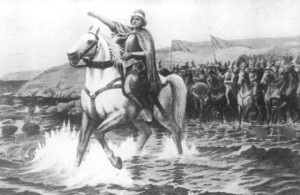
Ironically, several Polish historians now view the Lithuanian-Polish alliance as a mistake. Jogaila and Vytautas are blamed for ignoring Polish interests and pursuing Lithuanian objectives at the expense of Poland. For all practical purposes, they point out, Poland was indeed joined politically to Lithuania and not Lithuania to Poland. Poland, they maintain, never gained anything of value from the Lithuanian-Polish alliance after the defeat of the Germans. They further argue that the Lithuanian nobility adopted the Polish language and customs to insure their rule in Poland was finalized. Poor Jogaila seems to have no friends among most Lithuanian, Polish, German and Russian historians! Vytautas himself does not escape their criticism. Vytautas is blamed for welcoming thousands of Polish knights into Lithuania. He is further blamed for supporting and importing Polish Roman Catholic clerics into Lithuania where they provided a counterbalance to Eastern Orthodox russophile clerks in the chancellery of the Lithuanian Grand Duchy!
Vytautas the Great was a great man. He was indeed a great warrior. From his youth, he accompanied his father Kestutis to the battlefield. He was personally very courageous. He was a veteran of many hand-to-hand battles with the Germans, Tartars and Russians. He put his own life on the line for his country and people countless times. He was an astute diplomat, and continuously dealt with some of the most accomplished diplomats of his time. He skillfully conducted negotiations with the Holy Roman Emperor, the Pope, several Grand Masters of the Teutonic Knights, the Khans of the Golden Horde, the Sultan of Turkey, the Patriarch of the Greek Orthodox Church in Constantinople, the various Dukes and Great Dukes of Russia, Belarusia and Ukraine, not to mention the shrewd Polish nobility and his own stubborn Lithuanian bajorai. He was indeed the most respected sovereign in all of Europe in his day.
Vytautas lived to be about eighty years of age at a time in which most men died by their forties. Not only did he survive scores of battles, but disease as well. Vytautas was physically very strong and healthy. He was known for his habits of moderation. He never stuffed himself as did other sovereigns. He abstained totally from alcoholic beverages and was known for his high standards of cleanliness and personal morality. He was an exceptionally tolerant man. No individual in Lithuania was ever persecuted for his or her faith or nationality.
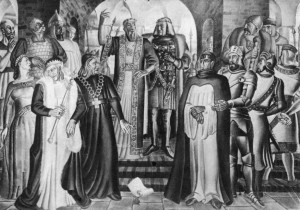
All were welcome in Vytautas’ Lithuania. Lithuania was the home of Lithuanians, Jews, Tartars, Karaims, Poles, Russians, Germans, Ukrainians and Belarusians as well as Armenians, Greeks, Latvians, and others. Vytautas was so known for his tolerance in religious matters that the Bohemians, then in intra-religious conflict between Catholics and Hussites, offered him their crown! Vytautas was a brilliant administrator who streamlined and modernized the Lithuanian government. There was nothing mean or vile in his nature. He was an educated man for his time. In addition to his native Lithuanian, he was no doubt also fluent to one or another degree in German, Eastern Slavonic, Polish, Latin and Tartar. He was a dreamer, yet a realist. He survived some 80 years in a most troubled world. He was noble — both in victory and defeat. Above all, he was courageous, tolerant and flexible in his dealing with others. He saved the Lithuanian people and state from the junk heap of history. He left his people with a legacy of pride that has in many ways sustained them for centuries through equally troubled times into our own day. He embodied the Lithuanian folk saying, “Kas bus, tas bus, o Lietuva nepražus” (“What will be will be, but Lithuania will never perish”).
Vytautas the Great died at Trakai on October 27,1430 — a mere twelve days before his planned official coronation as King of Lithuania. He was buried in the Cathedral of Vilnius, which he earlier had re-built.
 DRAUGAS NEWS Lithuanian World Wide News in English
DRAUGAS NEWS Lithuanian World Wide News in English
